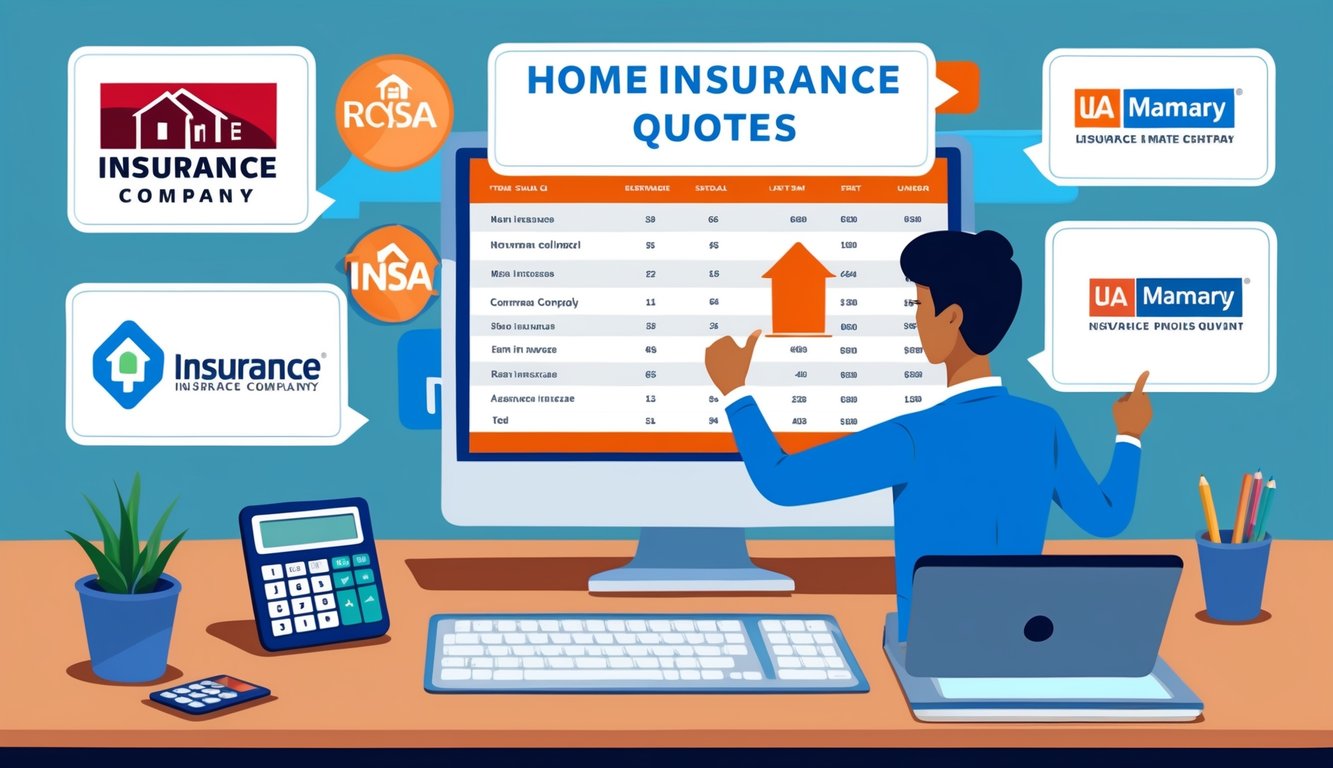Home insurance is a crucial safeguard for your property, but it’s important to ensure you’re not overpaying for coverage.
Many homeowners unknowingly spend more than necessary on their policies, missing out on potential savings.
You can take several steps to avoid overpaying for home insurance while still maintaining adequate protection for your property. By understanding the factors that influence your premiums and exploring various cost-saving strategies, you can potentially reduce your insurance expenses without compromising on essential coverage.
1) Compare multiple insurance quotes

To avoid overpaying for home insurance, it’s crucial to compare quotes from different providers.
Shopping around can help you find the best coverage at the most competitive price.
Start by obtaining quotes from at least three to five insurance companies.
Many insurers offer online quote tools that make this process quick and easy.
When comparing quotes, make sure you’re looking at similar coverage levels and deductibles.
This ensures you’re making an apples-to-apples comparison between policies.
Don’t just focus on the premium cost.
Consider the coverage limits, additional features, and the company’s reputation for customer service and claims handling.
Home insurance rates can vary significantly between companies, even for the same coverage.
Some insurers may offer better rates for specific home types or locations.
The cheapest option isn’t always the best, so look for a balance between affordable premiums and adequate coverage for your needs.
Consider working with an independent insurance agent who can provide quotes from multiple companies.
They may have access to insurers and deals you might not find on your own.
Remember to compare quotes annually or whenever your circumstances change.
Insurance rates can fluctuate, and you might find better deals over time.
2) Bundle home and auto policies
Bundling your home and auto insurance policies can lead to significant savings.
Many insurance companies offer discounts when you combine multiple policies with them.
These bundling discounts typically range from 5% to 25%, depending on the insurer.
The exact amount you save will vary based on your specific situation and the company you choose.
When considering bundling, compare offers from multiple insurers.
Some companies may provide better bundling discounts than others. State Farm, Erie, and Nationwide are often recognized for their competitive bundle packages.
Keep in mind that the cheapest bundle isn’t always the best option.
Consider the coverage levels and customer service reputation of each company when making your decision.
Bundling can also simplify your insurance management.
You’ll have one point of contact for both policies and may be able to align your payment schedules.
Remember to review your bundled policies annually.
Insurance needs can change over time, and you want to ensure you’re still getting the best value for your coverage.
3) Increase your deductible
Raising your home insurance deductible can significantly lower your premium costs.
The deductible is the amount you pay out of pocket when filing a claim before your insurance coverage kicks in.
By choosing a higher deductible, you assume more financial responsibility for potential claims.
In return, insurance companies typically offer lower monthly or annual premiums.
For example, increasing your deductible from $500 to $1,000 could save you up to 25% on your premiums.
This can result in substantial savings over time.
Before raising your deductible, ensure you have enough savings to cover the higher amount if you need to file a claim.
Consider your financial situation and risk tolerance when making this decision.
It’s important to weigh the potential savings against your ability to pay a larger deductible in the event of damage to your home.
If you rarely file claims, a higher deductible may be a smart choice to reduce your insurance costs.
Keep in mind that deductible increases are becoming more common as homeowners look for ways to manage rising insurance rates.
Many are finding it an effective strategy to balance coverage and affordability.
4) Improve home security systems
Installing a robust home security system can help lower your homeowners insurance premiums.
Many insurance companies offer discounts for homes equipped with security features that reduce the risk of theft or damage.
Smart home alarms like Ring and SimpliSafe can detect when doors and windows are opened or when there’s motion in your home.
These systems often come with easy DIY installation instructions and allow you to receive alerts on your smartphone.
Consider adding security cameras, motion sensors, and door locks that can be controlled remotely.
These features not only enhance your home’s safety but may also qualify you for insurance discounts.
Some insurers partner with specific home security providers.
Check with your insurance agent to see if choosing a system from a partnered company could lead to additional savings on both your premium and the security system itself.
The cost of installing a home security system can vary, but it typically ranges from $685 to $994.
Monthly monitoring services usually cost between $20 and $70.
While the initial investment may seem significant, the long-term benefits can be substantial. Home security systems can potentially reduce your insurance premiums by up to 10%.
This savings, combined with the added peace of mind, makes improving your home security a worthwhile consideration.
5) Maintain a good credit score
Your credit score can significantly impact your home insurance rates.
Many insurers use credit-based insurance scores to assess risk and determine premiums.
A higher credit score often leads to lower insurance costs. Insurers in many states may review your credit-based insurance score when considering your application.
To maintain a good credit score, pay your bills on time and keep your credit card balances low.
Regularly check your credit report for errors and dispute any inaccuracies you find.
Avoid opening too many new credit accounts at once, as this can temporarily lower your score.
Keep older credit accounts open, even if you don’t use them often, as they contribute to your credit history length.
A person with good credit might pay $1,915 per year for homeowners insurance, on average.
Those with poor credit could face significantly higher premiums.
By maintaining a good credit score, you not only improve your chances of getting better insurance rates but also enhance your overall financial health.
Remember, a higher credit score can lead to savings on various financial products, not just home insurance.
6) Look for discounts

Insurance companies offer various discounts that can significantly reduce your home insurance premiums.
Take advantage of these opportunities to save money.
Many insurers provide multi-policy discounts if you bundle your home and auto insurance together.
This can lead to substantial savings on both policies.
Installing safety devices like smoke detectors, security systems, and deadbolt locks can qualify you for discounts.
These improvements reduce the risk of damage or theft, making you a more attractive customer to insurance companies.
Loyalty discounts are often available for long-term customers.
Staying with the same insurer for several years may result in lower rates.
Some companies offer discounts for new homebuyers or those who have recently purchased a newly constructed home.
These properties typically have fewer maintenance issues and are less likely to experience problems.
Maintaining a good credit score can also lead to lower insurance rates.
Many insurers use credit-based insurance scores to determine premiums, so keeping your credit in good standing can help you save.
Consider raising your deductible to lower your premium.
Opting for a higher out-of-pocket expense in case of a claim can result in reduced monthly or annual costs.
Don’t hesitate to ask your insurance agent about all available discounts.
Some companies offer unique savings opportunities that may apply to your specific situation.
7) Review policy annually

Reviewing your homeowners insurance policy annually is crucial to ensure you’re not overpaying.
Your home’s value and personal circumstances can change year to year, affecting your coverage needs.
Set a reminder to review your policy before renewal.
This gives you time to make adjustments or shop around for better rates if necessary.
During your review, check if your coverage limits are still appropriate.
Your home’s value may have increased, requiring higher coverage.
Conversely, you might be able to reduce coverage on certain items.
Update your policy to reflect any major changes, such as home improvements or new security systems.
These updates could qualify you for discounts or require additional coverage.
Consider adjusting your deductible. Increasing your deductible can lower your premium, but ensure you can afford the higher out-of-pocket cost if you need to file a claim.
Review any additional coverage options you’ve added.
Determine if you still need them or if there are new options that better suit your current situation.
Don’t hesitate to ask your insurance agent questions during this review.
They can explain any policy changes and help you understand your coverage options.
8) Avoid small claims

Frequent small claims can significantly impact your home insurance premiums.
Insurance companies view multiple claims as a sign of increased risk, which may lead to higher rates or even policy non-renewal.
Raising your deductible can help prevent this issue.
By doing so, you’ll avoid making small claims that could potentially increase your long-term costs.
Paying for minor repairs out-of-pocket is another way to avoid making small claims.
By doing so, you’ll avoid making small claims that could potentially increase your long-term costs.
Consider reserving your insurance for more substantial damages or losses.
For instance, if a broken window costs $300 to replace, it’s often better to pay for it yourself rather than filing a claim.
Keep in mind that your claims history follows you when switching insurance providers.
This means that frequent claims can affect your rates even if you change companies.
Before filing a claim, compare the repair cost to your deductible.
If the difference is minimal, it’s usually more cost-effective to handle the expense yourself.
This approach helps maintain a clean claims record and potentially lower premiums.
Remember, insurance is designed to protect you from significant financial losses.
Using it for every minor issue can lead to increased costs in the long run.
By being selective about when you file claims, you can help keep your home insurance rates more affordable.
9) Consider actual cash value coverage

When shopping for home insurance, you may encounter the option of actual cash value (ACV) coverage.
This type of policy can help you save money on your premiums, but it’s important to understand how it works before making a decision.
ACV coverage pays out the depreciated value of your belongings in the event of a claim.
This means you’ll receive less money for older items compared to their original purchase price.
For example, if your five-year-old TV is damaged, an ACV policy will pay you what the TV is worth today, not what it cost when you bought it.
This can result in lower payouts compared to replacement cost coverage.
The main advantage of ACV coverage is that it typically costs about 8% less than replacement cost policies.
If you’re looking to reduce your insurance expenses, this option might be worth considering.
However, keep in mind that with ACV coverage, you may need to pay more out-of-pocket to replace your belongings after a loss.
This is especially true for items that depreciate quickly, like electronics or furniture.
Before choosing ACV coverage, carefully assess the value of your possessions and your ability to cover potential gaps in reimbursement.
If you have many valuable items or would struggle to replace them at current market prices, a replacement cost policy might be a better fit.
10) Address home hazards

Identifying and addressing potential hazards in your home can help reduce your insurance costs.
Insurance companies often view homes with fewer risks more favorably, leading to lower premiums.
Start by inspecting your property for common hazards.
Look for overhanging tree branches that could fall and damage your roof.
Trim these back to minimize the risk of storm-related damage.
Check your plumbing system for leaks or outdated pipes.
Upgrading your plumbing can prevent water damage and potentially lower your insurance costs.
Install smoke detectors and carbon monoxide alarms throughout your home if you haven’t already.
These devices not only enhance safety but may also qualify you for insurance discounts.
Consider installing a security system.
Many insurers offer discounts for homes with monitored alarm systems, as they reduce the risk of theft and break-ins.
Upgrade your electrical system if it’s outdated.
Old wiring can pose a fire risk, which insurers view as a significant hazard.
Modernizing your electrical system can improve safety and potentially lower your premiums.
Finally, address any structural issues in your home.
Repair damaged foundations, cracked walls, or leaky roofs.
These improvements can prevent future damage and demonstrate to insurers that you’re proactive about home maintenance.
Understanding Home Insurance Policies
Home insurance policies can be complex, with different types of coverage and potential misconceptions.
Knowing the key components and common misunderstandings can help you make informed decisions about your coverage.
Types of Home Insurance Coverage
Home insurance typically includes several types of coverage. Dwelling coverage protects your home’s structure from covered perils.
Personal property coverage insures your belongings.
Liability protection safeguards you if someone is injured on your property.
Additional living expenses coverage helps with costs if you need to temporarily relocate due to covered damage.
Some policies offer medical payments coverage for minor injuries to guests.
Optional endorsements can provide extra protection for valuables or specific perils.
It’s crucial to review your policy details carefully.
Understand what each type of coverage includes and excludes.
This knowledge will help you assess if you have adequate protection for your needs.
Common Misconceptions
Many homeowners mistakenly believe their policy covers all types of damage.
In reality, standard policies often exclude flood and earthquake damage.
Another misconception is that personal property is always covered at full replacement cost.
Some policies use actual cash value, which factors in depreciation.
Homeowners sometimes think their policy’s liability coverage extends to all situations.
However, it typically doesn’t cover intentional acts or business-related incidents.
Many assume the insurance amount should match their home’s market value.
In fact, it should cover the cost to rebuild your home, which can differ significantly.
Understanding these common misunderstandings can help you avoid coverage gaps and make more informed decisions about your home insurance.
Factors Influencing Home Insurance Costs
Several key elements determine how much you’ll pay for home insurance.
Your home’s location, value, and condition play crucial roles in setting premium rates.
Home Location and Risk Factors
Where you live significantly impacts your insurance costs. Areas prone to natural disasters like hurricanes, floods, or wildfires often have higher premiums.
Your ZIP code matters too, as insurers consider local crime rates and proximity to fire stations.
Urban areas may have higher rates due to increased theft risk.
Coastal properties face higher premiums because of potential storm damage.
If you live in a flood-prone area, you might need separate flood insurance.
Your neighborhood’s claim history can affect rates.
Areas with frequent claims may lead to higher premiums for all residents.
Impact of Home Value and Condition
Your home’s value directly influences insurance costs.
More expensive homes cost more to rebuild, resulting in higher premiums.
The age and condition of your house matter too.
Older homes often have higher premiums due to outdated systems and materials.
Insurers may offer discounts for recent renovations or upgrades, especially those that improve safety or durability.
The type of construction affects rates.
Brick homes may have lower premiums than wood-frame houses due to better fire resistance.
Your roof’s age and material can impact costs, with newer, more durable roofs potentially lowering premiums.
Strategies to Lower Your Home Insurance Premiums
Reducing your home insurance costs is achievable through several effective methods.
These approaches can help you maintain adequate coverage while keeping your premiums manageable.
Increasing Deductibles
Raising your deductible can significantly lower your home insurance premiums.
A deductible is the amount you pay out of pocket before your insurance coverage kicks in.
By increasing your deductible from $500 to $1,000, you could potentially save up to 25% on your premiums.
Some homeowners opt for even higher deductibles, like $2,500, for greater savings.
Before raising your deductible, ensure you have enough savings to cover it in case of a claim.
This strategy works best if you’re unlikely to file frequent small claims.
Bundling Insurance Policies
Combining multiple insurance policies with one company often leads to substantial discounts.
This practice is known as bundling.
Most insurers offer discounts when you bundle your home and auto insurance.
The savings can range from 5% to 25% off your premiums.
Some companies also allow bundling with life, boat, or other types of insurance for additional discounts.
Bundling not only saves money but also simplifies your insurance management.
You’ll have fewer bills to track and a single point of contact for multiple policies.
Seeking Discounts and Credits
Insurance companies offer various discounts that can help lower your premiums.
These discounts often reward actions that reduce risk or demonstrate responsibility.
Common discounts include:
- Security system installation
- Smoke detectors and fire alarms
- Impact-resistant roofing
- Claims-free history
- New home construction
You might also qualify for discounts based on your profession, age, or membership in certain organizations. Improving your credit score can lead to lower premiums in many states.
Ask your insurer about available discounts.
Periodically review your policy to ensure you’re taking advantage of all possible savings opportunities.






